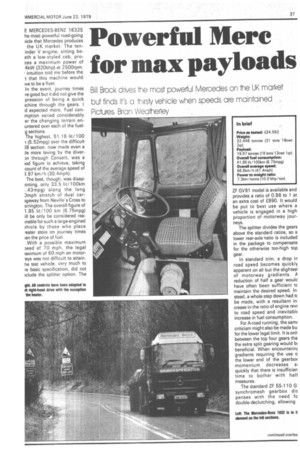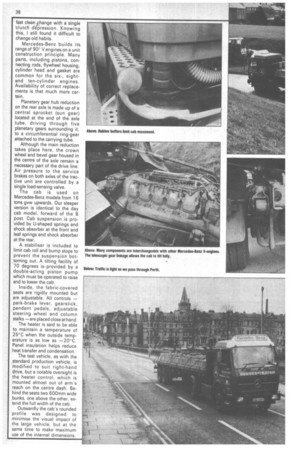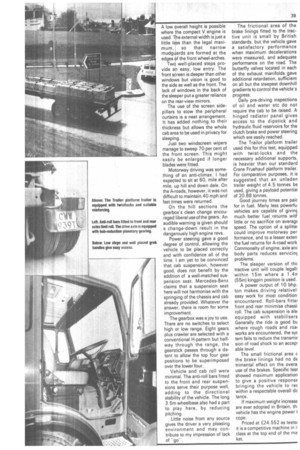Powerful Mere for max payloads
Page 39

Page 40

Page 41

If you've noticed an error in this article please click here to report it so we can fix it.
Bill Brock drives --ne most powerful Mercedes on the UK marKet
but finds it's a irsly vehicle when speeds are maintained Pictures: Brian Wea erley
E MERCEDES-BENZ 1632S he most powerful road-going licle that Mercedes produces the UK market. The teninder V engine, sitting beath a low-styled cab, proces a maximum power of 4kW (320bhp) at 2500rpm. intuition told me before the t that this machine would ive to be a flyer.
In the event, journey times .re good but it did not give the pression of being a quick )chine through the gears. I d expected more. Fuel conmotion varied considerably er the changing terrain enuntered over each of the fuel9 sections.
The highest, 51.18 lit/100 1(5.52mpg) over the difficult 38 section, now made even a :le more taxing by the diver)11 through Consett, was a cid figure to achieve, taking count of the average speed of 3.97 km /h (30.4mph).
The best, though, was disap)inting, only 33.5 lit/100km .43mpg) along the long Dmph stretch of dual carigeway from Neville's Cross to arrington. The overall figure of 1.85 lit/100 km (6.75mpg) ill be only be considered reainable for such a large-engined .thicle by those who place 'eater store on journey times an the price of fuel.
With a possible maximum )eed of 70 mph, the legal iaximum of 60 mph on motorrays was not difficult to attain. he test vehicle, very much to ie basic specification, did not iclude the splitter option. The ZF GV91 model is available and provides a ratio of 0.86 to 1 at an extra cost of £990. It would be put to best use where a vehicle is engaged in a high proportion of motorway journeys.
The splitter divides the gears above the standard ratios, so a lower rear-axle 'ratio is included in the package to compensate for the otherwise too-high top gear.
In standard trim, a drop in road speed becomes quickly apparent on all but the slightes1 of motorway gradients. A reduction of half a gear would have often been sufficient tc maintain the desired speed. In stead, a whole step down had tc be made, with a resultant in crease in the ratio of engine rev: to road speed and inevitabk increase in fuel consumption.
For A-road running, the sam( criticism might also be made bu for the lower legal limit. It is onll between the top four gears tha the extra split gearing would bi beneficial. When encounterini gradients requiring the use o the lower end of the gearbox momentum decreases si quickly that there is insufficien time to bother with half measures.
The standard ZF 5S-110 G' synchromesh gearbox dis. penses with the need ft double-declutching, allowing fast clean ,change with a single 'clutch depression, Knowing this, I still found it difficult to change old habits.
Mercedes-Benz builds its, range of 90'-V engines on a unit
construction principle. Many
parts, including pistons, connecting rods, flywheel housing,
cylinder head and gasket are common for the six-, eightand ten-cylinder engines. Availability of correct replacements is that much more certain.
Planetary gear hub reduction on the rear axle is made up of a central sprocket (sun gear) located at the end of the axle tube, driving through five planetary gears surrounding it, to a circumferential ring-gear attached to the carrying tube.
Although the main reduction takes place here, the crown wheel and bevel gear housed in the centre of the axle remain a necessary part of the drive line.
Air pressure to the service brakes on both axles of the tractive unit are controlled by a single load-sensing valve.
The cab is used on Mercedes-Benz models from 16 tons gvw upwards. Our sleeper version is identical to the day cab model, forward of the B post. Cab suspension is provided by U-shaped springs and shock absorber at the front and leaf springs and shock absorber at the rear.
A stabiliser is included to limit cab roll and bump stops to prevent the suspension bot toming out. A tilting facility of 70 degrees is provided by a double-acting piston pump which must be operated to raise and to lower the cab.
Inside, the fabric-covered seats are rigidly mounted but are adjustable. All controls — park-brake lever, gearstick, pendant pedals, adjustable steering wheel and column stalks —are placed close at hand.
The heater is said to be able to maintain a temperature of
25C when the outside temperature is as low as —20'C.
Panel insulation helps reduce heat transfer and condensation.
The test vehicle, as with the standard production vehicle, is modified to suit right-hand drive, but a notable oversight is the heater control, which is mounted almost out of arm's reach on the centre dash. Behind the seats two 600mm wide bunks, one above the other, extend the full width of the cab.
Outwardly the cab's rounded profile was designed to minimise the visual impact of the large vehicle, but at the same time to make maximum use of the internal dimensions. A low Overall height is possible where the compact V engine is used. The external width is just a little less than the legal maximum, so that narrow mudg ards are formed at the edges f the front wheel-arches.
Tw well-placed steps provide a easy, low entry. The front screen is deeper than other windows but vision is good to the side as well as the front. The lack of windows in the back of the sleeper put a greater reliance on the rear-view mirrors.
The use of the screen sidepillars to stow the peripheral curtains is a neat arrangement. It has added nothing to their thickness but allows the whole cab area to be used in privacy for sleeping.
Just two windscreen wipers manage to sweep 70 per cent of the front screen. This might easily be enlarged if longer blades were fitted.
Motorway driving was something of an anti-climax. I had expected to sit at 60, mile after mile, up hill and down dale. On the A-roads, however, it was not difficult to maintain 40 mph and fast times were returned.
On the hill sections the gearbox's clean change encouraged liberal use of the gears. An audible warning is given should a change-down result in the dangerously high engine revs.
Power steering gave a good degree of control, allowing the vehicle to be placed correctly and with confidence all of the time. I am yet to be convinced that cab suspension, however good, does not benefit by the addition of a well-matched suspension seat. Mercedes-Benz claims that a suspension seat here will not harmonise with the springing of the chassis and cab already provided. Whatever the answer, there is room for some improvement.
The gearbox was a joy to use. There are no switches to select high or low range. Eight gears plus crawler are selected with a conventional H-pattern but halfway through the range, the gearstick passes through a detent to allow the top four gear positions to be superimposed over the lower four.
Vehicle and cab roll were minimal. The anti-roll bars fitted to the front and rear suspensions serve their purpose well, adding to the directional stability of the vehicle. The long 3.5m wheelbase also had a part to play here, by reducing pitching.
Little noise from any source gives the driver a very pleasing environment and may contribute to my impression of lack of "go-.
The frictional area of the brake linings fitted to the tractive unit is small by British standards, but the vehicle gave a satisfactory performance when maximum decelerations were measured, and adequate performance on the road. The butterfly valves located in each of the exhaust manifolds gave additional retardation, sufficient on all but the steepest downhill gradients to control the vehicle's progress.
Daily pre-driving inspections of oil and water etc do not require the cab to be raised. A hinged radiator panel gives access to the dipstick and hydraulic fluid reservoirs for the clutch brake and power steering which are easily reached.
The Trailor platform trailer used this for this test, equipped with twist-locks and the necessary additional supports, is heavier than our standard Crane Fruehauf platform trailer. For comparative purposes, it is suggested that an unladen trailer weight of 4.5 tonnes be used, giving a payload potential of 20.88 tonnes.
Good journey times are paic for in fuel. Many less powerfu vehicles are capable of givinc much better fuel returns with little or no sacrifice on average speed. The option of a splittel could improve motorway per formance, and to a lesser exten. the fuel returns for A-road work Commonalty of engine, axle anc body parts reduces servicinc problems.
The sleeper version of thi: tractive unit will couple legalh within 15m where a 1.4n (55in) kingpin position is used.
A power output of 10 bhp, ton makes driving relativel,
easy work for most condition encountered. Roll-bars fine( front and rear minimise chassi roll. The cab suspension is alsi equipped with stabilisers Generally the ride is good bu where rough roads and roe, works are encountered, the syE tern fails to reduce the transmiE sion of road shock to an accepi able level.
The small frictional area c the brake linings had no de trimental effect on the overa use of the brakes. Specific test showed maximum application to give a positive response bringing the vehicle to reE within a respectable overall di: tance.
If maximum weight increase are ever adopted in Britain, tK vehicle has the engine power t cope.
Priced at £24,552 as testec it is a competitive machine in ii class at the top end of the ma ket.




























































































































































































